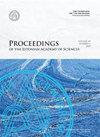顺特水的微生物学和化学性质
IF 0.7
4区 综合性期刊
Q3 MULTIDISCIPLINARY SCIENCES
引用次数: 2
摘要
. 摘要Shungite用于滤水器,可以去除水中的大肠杆菌。顺石抗菌活性的机理和谱尚不清楚。本研究采用x射线衍射、x射线荧光和碘量法对顺石及其干水提取物进行了表征。顺云石水提物的干燥残渣碳(岩石28.1%,残渣0.5%)、硅(岩石23.9%,残渣0.3%)和钾(1.14%,0.05%)含量相对较低,但硫(1.6%,21.6%)和一些金属,包括铁(1.4%,10%)、铝(2.1%,5%)和镍(0.02%,1.14%)含量丰富。测定了大肠杆菌、铜绿假单胞菌、金黄色葡萄球菌、白色念珠菌、ubercoccus和酿酒酵母菌在顺特水中的存活率。大肠杆菌、铜绿假单胞菌和ubercoccus在3:7 shungite水提取物中不能存活24小时,而金黄色葡萄球菌、白色念珠菌和酿酒酵母在蒸馏水中也能存活24小时。pH值的中和并没有消除其杀菌作用。然而,在营养物质存在的情况下,顺特水没有显示出抑菌或杀菌效果。本文章由计算机程序翻译,如有差异,请以英文原文为准。
Microbiological and chemical properties of shungite water
. Abstract. Shungite is used in water filters that remove Escherichia coli from water. The mechanism and spectrum of the antibacterial activity of shungite are not precisely known. In this study, shungite and its dried water extract were characterized by means of X-ray diffraction, X-ray fluorescence and iodometry. The dried residue of the water extract of shungite was relatively poor in carbon (28.1% in the rock vs 0.5% in the residue), silica (23.9% in the rock vs 0.3% in the residue) and potassium (1.14% vs 0.05%), but rich in sulfur (1.6% vs 21.6%) and some metals, including iron (1.4% vs 10%), aluminum (2.1% vs 5%) and nickel (0.02% vs 1.14%). The survival of Escherichia coli , Pseudomonas aeruginosa , Staphylococcus aureus , Candida albicans , Streptococcus uberis and Saccharomyces cerevisiae in shungite water was measured. Escherichia coli , Pseudomonas aeruginosa and Streptococcus uberis did not survive for 24 hours in 3:7 shungite water extract, while Staphylococcus aureus , Candida albicans and Saccharomyces cerevisiae survived as well as in distilled water. Neutralization of pH did not abolish the bactericidal effect. However, in the presence of nutrients, shungite water did not show bacteriostatic or bactericidal effects.
求助全文
通过发布文献求助,成功后即可免费获取论文全文。
去求助
来源期刊

Proceedings of the Estonian Academy of Sciences
综合性期刊-综合性期刊
CiteScore
1.80
自引率
22.20%
发文量
24
审稿时长
>12 weeks
期刊介绍:
The Proceedings of the Estonian Academy of Sciences is an international scientific open access journal published by the Estonian Academy of Sciences in collaboration with the University of Tartu, Tallinn University of Technology, Tallinn University, and the Estonian University of Life Sciences.
The journal publishes primary research and review papers in the English language. All articles are provided with short Estonian summaries.
All papers to be published in the journal are peer reviewed internationally.
The journal is open to word-wide scientific community for publications in all fields of science represented at the Estonian Academy of Sciences and having certain connection with our part of the world, North Europe and the Baltic area in particular.
 求助内容:
求助内容: 应助结果提醒方式:
应助结果提醒方式:


